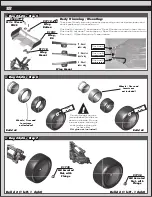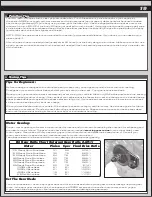
20
:: Tuning Tips (cont.)
Rear Camber:
Camber describes the angle at which the tire and wheel rides when looked at from the back. Negative camber means
that the tire leans inward at the top. A good starting camber setting is -1°. Adding a small amount of positive camber,
where the top of the tire is leaning out, will tend to improve straight-line acceleration on loose tracks.
Optional #1719 camber gauge can be used to more accurately set camber.
Slipper Clutch:
The assembly instructions give you a base setting for your clutch. Turn the nut on the shaft so that the end of the top
shaft is even with the outside of the nut. At the track, tighten or loosen the nut in 1/8 turn increments until you hear
a faint slipping sound for 1-2 feet on takeoffs. Another popular way to set the clutch is to hold both rear tires firmly in
place and apply short bursts of throttle. If the clutch is properly set, the front tires should lift slightly up off the surface.
Front Camber:
Camber describes the angle at which the tire and wheel rides when
looked at from the front. Negative camber means that the tire leans
inward at the top. A good starting camber setting is -1°. Positive camber,
where the top of the tire is leaning out, is not recommended.
Optional #1719 camber gauge can be used to more accurately set camber.
*Testing camber
with camber gauge
!
Front Camber Links:
Changing the length of the camber link is considered a bigger step than
adjusting the ball end height on the tower. Shortening the camber link
(or lowering the ball end) will give the front end less roll and quicken steering
response. Lengthening the camber link (or raising the ball end) will give the
front more roll and slower steering response. Longer camber links are
typically used on high grip tracks and shorter links tend to work better on
medium-grip loose tracks.
*Raise or lower the
ball end by adding
or removing
washers here
!
Rear Camber Link:
Changing the length of the camber link is considered a bigger step than adjusting
the ball end height on the rear chassis brace. Shortening the camber link
(or lowering the ball end) will give the rear end less roll and the car will tend to
accelerate or “square up” better. Lengthening the camber link (or raising the ball
end) will give the rear more roll and more cornering grip. Longer camber links are
typically used on high grip tracks, while shorter links tend to work better on
medium grip loose tracks. The kit setting is the best compromise of cornering grip
and acceleration.
*Raise or lower
the ball end by
adding or
removing
washers here
!
Gear Box Type:
Selecting the correct gear box is dependent on the type of track it will be used on. The optional 4 gear stand-up gear
box is for the lowest grip conditions. This gear box moves the weight towards the rear of the car and also uses the
rotation of the motor to transfer weight to the rear while on-power. The 3 gear stand-up gear box also moves the
weight towards the rear of the car, but in this configuration, the motors rotation helps with on-power steering.
The lay-down gear box is used on high grip conditions when on-power steering and stability are most important.
This gear box will change directions the quickest and generate the most steering.
Caster:
Caster describes the angle of the kingpin as it leans toward the rear of the vehicle. Positive caster means the kingpin
leans rearward at the top. The B6 includes three inserts to adjust caster angle at the caster block, 0
°
,
2.5
°
, and +5
°
.
The total caster angle is the sum of the kick-up angle and the caster block angle. Standard total caster angle for the
B6 is 30
°
, with 25
°
kick-up and +5
°
caster block angle.
For less entry steering and more exit steering, try 0
°
caster block angle.
Summary of Contents for RC10B6
Page 1: ... 90011 RC10B6 Team Kit ...















































